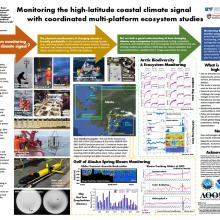Demonstrating High Latitude Physics-to-Whales Ecosystem Monitoring with a Multi-Platform Approach
Seth
Danielson
University of Alaska Fairbanks
Poster
Alaska’s continental shelves and marine ecosystems strongly manifest impacts of an altered climate with warming, ocean acidification and shifting species distributions. Time series measurements are essential for monitoring and understanding environmental and ecological processes that are likely to change in unanticipated ways. Severe winter storms and seasonal sea ice cover in high latitude waters constrain the available practical approaches to ecosystem monitoring, but new technologies are now enabling year-round observations across many disciplines and all trophic levels. Ship surveys service mobile underwater gliders and fixed moorings; they together provide multi-faceted views into ecosystem status and trajectory. Moored platforms collect high-temporal-resolution sensor data and physical samples destined for later laboratory analysis, such as preserved water and suspended sediment samples. Underwater gliders resolve water column hydrographic vertical and horizontal structure and provide near-real time data from optical, active acoustic and passive acoustic sensors. Thus, autonomous ecosystem monitoring now characterizes key aspects of the ecosystem, including physics, nutrient and carbonate chemistry, carbon export, phytoplankton and zooplankton, fish, benthic epifauna, and marine mammals. As autonomous platform monitoring programs and sensors continue to mature, an emerging challenge now is the effective application of these data to filling research and management needs. High-volume and disparate data streams present analysis challenges and optimal data utilization will require new data management, processing, and analysis techniques. This presentation will highlight case studies that demonstrate the above approach.

Poster file
danielson-seth-poster.pdf
(2.84 MB)
